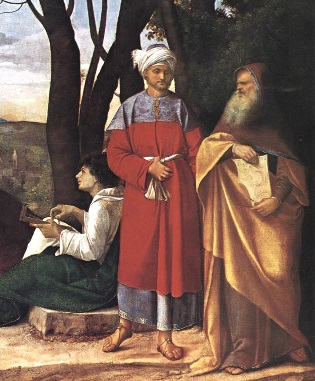 893 years ago today, on April 14th, 1126, the great Islamic philosopher, theologian, political theorist, and scientist Ibn Rushd, or as he is known by the Latinate version of his name in Europe, Averroes, was born.
893 years ago today, on April 14th, 1126, the great Islamic philosopher, theologian, political theorist, and scientist Ibn Rushd, or as he is known by the Latinate version of his name in Europe, Averroes, was born.
Among his many achievements, Averroes is credited with popularizing the study of Aristotle in Europe, inspiring the work of Thomas Aquinas and the Christian Scholastics. Averroes was known as “The Commentator” and Aristotle “The Philosopher” to Aquinas and the Scholastics, as Averroes wrote multiple commentaries to help others understand Aristotle’s thought. To the left is an image of Averroes standing between and above an ancient Greek sage, likely Aristotle, and an Italian scholar of the Renaissance, sitting at their feet, painted by Giorgione of Venice. Averroes was also a major influence on Maimonides, Giordano Bruno, Pico della Mirandola, and Baruch Spinoza, and was one of the great souls that Dante wrote was dwelling in limbo with the Greek sages who lived before Jesus.

Thomas Aquinas
Averroes’ grandfather and father both served as chief judge of Cordoba, the place where Averroes was born, which later became part of Spain. Averroes wrote prolifically, twenty-eight works of philosophy as well as important treatises on law and medicine. As a rationalist, Averroes argued that philosophy and religion teach the same truth and thus are not in conflict, such that intellectuals pursue the same matters that common people comprehend through religion and rhetoric. He also argued that analytic thinking was important for the proper interpretation of the Quran, as Christian Scholastics would argue later about the Bible in Europe. Averroes’ works were banned and burned in Islamic and Christian lands at different times, but they were revered enough to survive in both places.
Averroes was opposed to the work of Al-Ghazali, the Sufi mystic and author of The Incoherence of the Philosophers. Ghazali argued that philosophers such as Plato, Aristotle, Al-Farabi and Avicenna contradict each other, and are thus incoherent as a set, and also contradict the teachings of Islam. Ghazali also argued that Aristotle and those who follow him are wrong to assert that nature proceeds according to established laws, as all things proceed directly through the will of God. Averroes wrote his most famous work, The Incoherence of the Incoherence, in response to Ghazali. Averroes defended Aristotle and argued that philosophy does lead to coherent truth, which is not in conflict with Islam, and that nature proceeds indirectly from God via the laws of nature, which God established during creation.

Portrait of Baruch de Spinoza (1632-1677), ca. 1665, by an unknown artist
Averroes is also famous for his idea of monopsychism, that we all share the same divine soul, mind, and awareness, with each taking a part such that the lower soul is individual and mortal but the higher soul is universal and immortal, the source of true inspiration and reason. Spinoza, who said that each of us is like a wave on the great sea of being, was a pantheist, inspired in part by Averroes. Much later, when Albert Einstein was asked if he believed in God, he said, in the spirit of Averroes, “I believe in Spinoza’s god”.
In these and countless other instances, we can discern the influence of Averroes throughout both Eastern and Western thought. Thank you for your wisdom and insight, Averroes!
*A version of this piece was previously published at Ordinary Philosophy
~ Ordinary Philosophy is a labor of love and ad-free, supported by patrons and readers like you. Any support you can offer will be deeply appreciated!
*All views and opinions expressed by guest writers are their own and do not necessarily express those of Ordinary Philosophy’s editors and publishers

